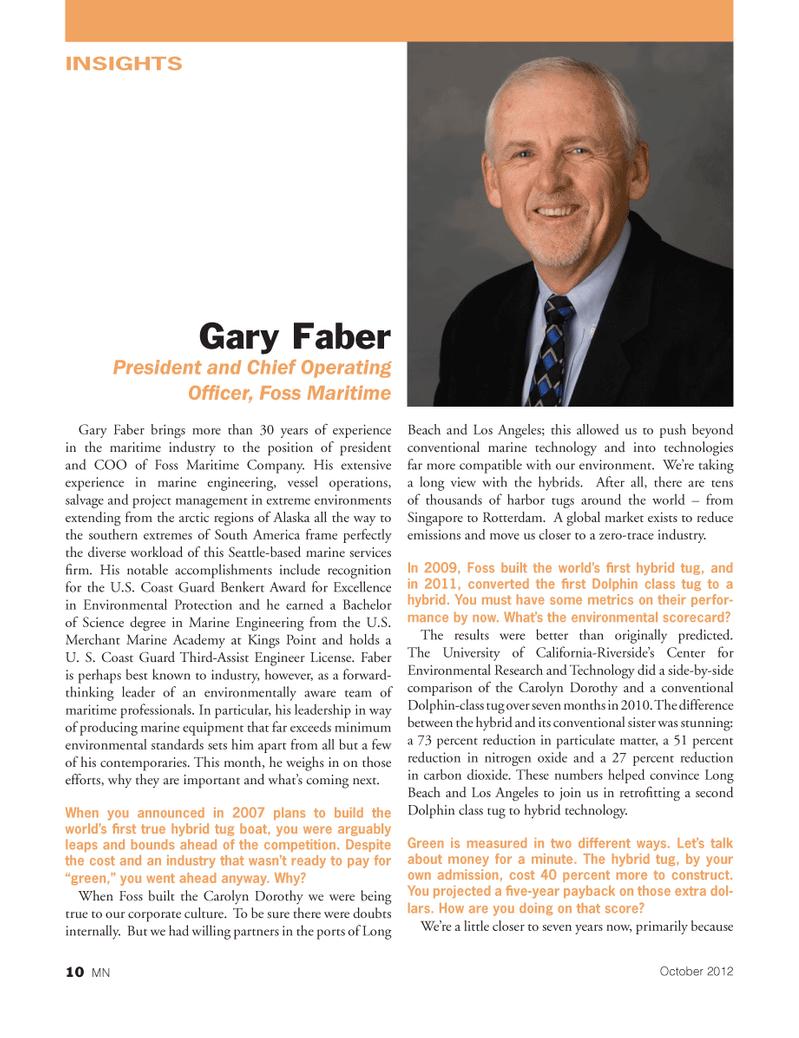
Page 10: of Marine News Magazine (October 2012)
Year in Review & Leadership
Read this page in Pdf, Flash or Html5 edition of October 2012 Marine News Magazine
Gary Faber brings more than 30 years of experience in the maritime industry to the position of president and COO of Foss Maritime Company. His extensive experience in marine engineering, vessel operations, salvage and project management in extreme environments extending from the arctic regions of Alaska all the way to the southern extremes of South America frame perfectly the diverse workload of this Seattle-based marine services Þ rm. His notable accomplishments include recognition for the U.S. Coast Guard Benkert Award for Excellence in Environmental Protection and he earned a Bachelor of Science degree in Marine Engineering from the U.S. Merchant Marine Academy at Kings Point and holds a U. S. Coast Guard Third-Assist Engineer License. Faber is perhaps best known to industry, however, as a forward- thinking leader of an environmentally aware team of maritime professionals. In particular, his leadership in way of producing marine equipment that far exceeds minimum environmental standards sets him apart from all but a few of his contemporaries. This month, he weighs in on those efforts, why they are important and whatÕs coming next. When you announced in 2007 plans to build the world?s rst true hybrid tug boat, you were arguably leaps and bounds ahead of the competition. Despite the cost and an industry that wasn?t ready to pay for ?green,? you went ahead anyway. Why? When Foss built the Carolyn Dorothy we were being true to our corporate culture. To be sure there were doubts internally. But we had willing partners in the ports of Long Beach and Los Angeles; this allowed us to push beyond conventional marine technology and into technologies far more compatible with our environment. WeÕre taking a long view with the hybrids. After all, there are tens of thousands of harbor tugs around the world Ð from Singapore to Rotterdam. A global market exists to reduce emissions and move us closer to a zero-trace industry. In 2009, Foss built the world?s rst hybrid tug, and in 2011, converted the rst Dolphin class tug to a hybrid. You must have some metrics on their perfor- mance by now. What?s the environmental scorecard? The results were better than originally predicted. The University of California-RiversideÕs Center for Environmental Research and Technology did a side-by-side comparison of the Carolyn Dorothy and a conventional Dolphin-class tug over seven months in 2010. The difference between the hybrid and its conventional sister was stunning: a 73 percent reduction in particulate matter, a 51 percent reduction in nitrogen oxide and a 27 percent reduction in carbon dioxide. These numbers helped convince Long Beach and Los Angeles to join us in retroÞ tting a second Dolphin class tug to hybrid technology. Green is measured in two different ways. Let?s talk about money for a minute. The hybrid tug, by your own admission, cost 40 percent more to construct. You projected a ve-year payback on those extra dol- lars. How are you doing on that score? WeÕre a little closer to seven years now, primarily because INSIGHTSGary FaberPresident and Chief Operating OfÞ cer, Foss Maritime 10 MNOctober 2012MNOct2012 Layout 1-17.indd 10MNOct2012 Layout 1-17.indd 1010/2/2012 9:31:42 AM10/2/2012 9:31:42 AM

 9
9

 11
11
